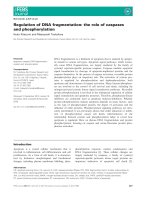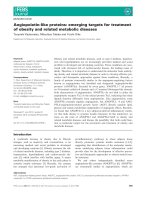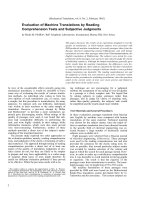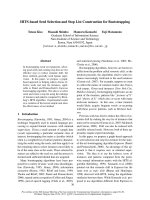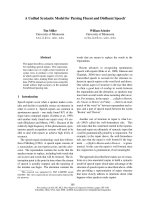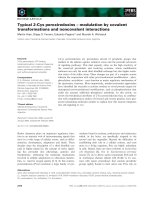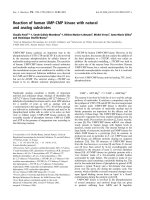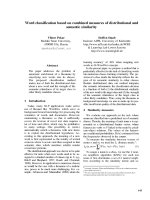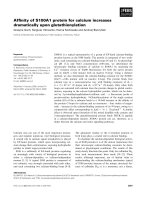Báo cáo khoa học: "CT-guided iodine-125 seed permanent implantation for recurrent head and neck cancers" doc
Bạn đang xem bản rút gọn của tài liệu. Xem và tải ngay bản đầy đủ của tài liệu tại đây (425.88 KB, 7 trang )
RESEA R C H Open Access
CT-guided iodine-125 seed permanent
implantation for recurrent head and neck cancers
Yu L Jiang
1
, Na Meng
1
, Jun J Wang
1*†
, Ping Jiang
1
, Hui SH Yuan
2†
, Chen Liu
2
, Ang Qu
1
, Rui J Yang
1
Abstract
Background: To investigate the feasibility, and safety of
125
I seed permanent implantation for recurrent head and
neck carcinoma under CT-guidance.
Results: A retrospective study on 14 patients with recurrent head and neck cancers undergone
125
I seed
implantation with different seed activities. The post-plan showed that the actuarial D90 of
125
I seeds ranged from
90 to 218 Gy (median, 157.5 Gy). The follow-up was 3 to 60 months (median, 13 months). The median local control
was 18 months (95% CI, 6.1-29.9 months), and the 1-, 2-, 3-, and 5- year local controls were 52%, 39%, 39%, and
39%, respectively. The 1-, 2-, 3-, and 5- survival rates were 65%, 39%, 39% and 39%, respectively, with a median
survival time of 20 months (95% CI, 8.7-31.3 mont hs). Of all patients, 28.6% (4/14) died of local recurrence, 7.1% (1/
14) died of metastases, one patient died of hepato cirrhosis, and 8 patients are still alive to the date of data
analysis.
Conclusion: CT-guided
125
I seed implantation is feasible and safe as a salvage or palliative treatment for patients
with recurrent head and neck cancers.
Background
Most patients who have ever undergone surgery for
head and neck cancer or those local advanced or regio-
nal recurrence cancer patients received surgery com-
bined with adjuvant external-beam radiotherapy (EBRT)
[1,2]. Management of patients with recurrent head and
neck cancers after surgery, EBRT, and adjuvant che-
motherapy is a challenge for clinical oncologists. Salvage
surgery is often technically feasible after the patients
treated with full doses of EBRT, but the c urati ve poten-
tial of surgery alone is low; further, the morbidity is
high [3]. Redelivery of effective doses of EBRT is diffi-
cult because of the limited tolerance of ad jacen t normal
tissues. Therefore, there has been a growing interest in
combining salvage surgery with intraoperative interstitial
brachytherapy [4].
Temporary intraoperative interstitial brachytherapy
has its advantage in this aspect, in which a high dose of
radiation is delivered directly to the cancer, while ensur-
ing that a much lower dose is delivered to the adjacent
normal structures [5-7]. The use of high-dose rate
(HDR) and low-dose rate (LDR) brachytherapy in pre-
viously irradiated regions is often safe because the use
of implants ensures the delivery of the dose to very spe-
cific and limited volumes of tissue. A variety of isotopes
are available for use as HDR or LDR temporary intersti-
tial brachytherapy, but the most commonly used isotope
is Iridium-192, Co-60 or Cs-137 et al, especially for
treating recurrent solid cancers [8-10]. However, the use
of t hose isotopes for intraoperative HDR brachytherapy
requires very complicated shielding [11].
Computed tomography (CT)-guided permanent bra-
chytherapy was initially used for treating liver malignan-
cies [12,13]. This novel technique ensures protracted
cell killing over a period of several months through tar-
geted delivery of high-dose radiati on. The ad vantages of
this technique are as follows: (1) it is minimally invasive,
(2) dose distribution can be accurately predicted, (3)
continuous irradiation increases the likelihood of dam a-
ging malignant cells in a vulnerable phase of the cell
cycle, and ( 4) the incidence rate of acute adverse effects
is low.
We have gained significant experience in using perma-
nent
125
I seed implantation for treating recurrent rectal
* Correspondence:
† Contributed equally
1
Department of Radiation Oncology, Peking University Third Hospital, Beijing
100191, PR China
Jiang et al. Radiation Oncology 2010, 5:68
/>© 2010 Jiang et al; licensee BioMe d Central Ltd. This is an Open Access article distributed under the terms of the Creative Commons
Attribution License (http://creativec ommons.org/licenses/by/2.0), which permits unrestricted use, distribution, and reproduction in
any medium, provided the original work is properly cited.
cancer and spinal metastases [14,15]. The theoretical
benefit of seed permanent implantation as a salvage
treatment is enhanced disease control in the region of
recurrence through precise and continuous LDR irradia-
tion, which, in turn, minimizes injury to the overlying
skin and surrounding neurovascular structures.
In this study, we investigated the efficacy and feasibil-
ity of percutaneous CT-guided
125
I seed permanent
implantation for recurrent head and neck cancers and
analyzed the local control, survival and complications o f
this modality.
Patients and me thods
We conducted a retrospective analysis of 14 patients
(median age, 40 years; range, 19-74 years) who had been
treated for recurrent head and neck cancers with CT-
guided
125
I seed permanent implantati on at Peking Uni-
versity Third Hospital between Feb 2003 and November
2009. The study population included 9 male and 5
female patients. The criteria for eligibility were as fo l-
lows: histologically proven recurrent head and neck can-
cer after surgery and radiotherapy, without any evidence
of distant metastasis; a Karnofsky Performance Status
(KPS) score ≥60; and no severe impairment of kidney,
liver, or bone marrow function. The diameter of recur-
rent tumor was less than 7 cm. All patients had ever
been reviewed by the surgeons and radiation oncolo-
gists, and were considered not suitable for salvage sur-
gery and EBRT again or the patients refused to receive
surgery and EBRT further.
Before the operation, we evaluated the history and
physical condition of all the patients, hematological
and chemical tests, and obtained CT images of th e head
and neck and radiographs of the chest. Patient charac-
teristics are shown in Table 1.
Of the 14 patients, 2 had undergone radical surgery
alone, 6 had received EBRT alone, and 6 had undergone
surgery and EBRT. Two patients had undergone surgery
twice and the other two patients had undergone surgery
three times. Among the patients who underwent EBRT,
1, 5, and 6 patients received it 4 times, twice, and once,
respectively. The total dose delivered to PTV ranged
from 48.5 to 250 Gy (median, 70 Gy). Six patie nts had
been administered chemotherapy (3-13 cycles; median, 4
cycles). Five patients had regional recurrence in the
lymph nodes and 9 patients had recurrence in the pri-
mary lesions.
A detailed CT-aided tumor-volume study was also
performed for all the patients 1-2 weeks before seed
impl antation. We obtained transverse image s of the tar-
gets at 5-mm intervals. The images were transferred to
a computerized treatment planning system (TPS, Pro-
wess, version 3.02, SSGI, USA). The radiation oncologist
outlined the planning target volume (PTV) on each
transverse image, to which the prescribed D90 (the
doses delivered to 90% of the target volume) was pre-
scribed. The PTV included the gross tumor volume
(GTV) with a 0.5-1 cm margin. A radiation dose of 90-
160 Gy was prescribed to the PTV and calculated
through computerized treatment planning system.
We had previously reported the implant technique
used in this study [14]. Seed implantation was per-
formed in all the 14 patients under local anesthesia in
the CT room. After determining the target volume, 18-
gauge interstitial needles were inserted into the tumor
through the skin surface with PTV under CT supervi-
sion. Most of the 18-gauge needles were placed 1.0 cm
apart in a parallel array in the PTV. Precautions were
taken to avoid puncturing the large vascular and neur al
Table 1 Patient characteristics (n = 14)
No. of patients Percentage (%)
Median age 40(range,19-74)
Gender
Male 9 64
Female 5 36
KPS
60 1 7
70 4 29
80 6 43
90 2 14
100 1 7
Primary tumor stage
Stage I 1 7
Stage II 3 21
Stage III 4 29
Stage IV 5 36
Unclear 1 7
Primary tumor
Sinus paranasal 5 36
Nasopharynx carcinoma 3 21
Larynx 2 14.3
Hypopharyngeal carcinoma 1 7
Nasal cavity 1 7
Mandible 1 7
Infratemporal fossa 1 7
Previous surgery 8 57
Previous chemotherapy 6 43
Previous radiotherapy 12 86
One 7 50
Two 4 29
Four 1 7
Previous cumulative dose(Gy)
≤50 Gy 2 14
50 ~ 100 Gy 5 36
>100 Gy 5 36
Median dose(Gy) 70(range,50-250)
Jiang et al. Radiation Oncology 2010, 5:68
/>Page 2 of 7
structures and the bronchus. The median number of
needles is 14 (range, 5-42). After placing the needles,
125
I seeds (Model 6711; Beijing Atom and High Techni-
que Industries Inc., Beijing) were implanted using a
Mick applicator; the seeds were implanted 1.0 cm apart.
All the patients received perioperative prophylactic
antibiotics.
Postoperative dosimetric measurements were routinely
obtained for al l the patients. The implant dosimetry was
determined using three-dimensional seed identification,
and axial CT images (slice thickness, 5 mm) of the
impl anted area were obtained immedi ately or 24 h after
seed implantation. The CT-derived postimplant target
volumes were defined to encompass the GTV with a
0.5-1 cm margin. The
125
I seeds were identified on the
CT images by using a combination of manual selection
and an automated redundancy check feature available
on the Prowess treatment planning system. We gener-
ated isodose curves for each slice (Fig. 1) and dose-
volume histograms of the target (Fig. 2). The actuarial
median number of the implanted
125
I seeds was 48
(range, 21-158). The specific activity of
125
I seeds ranged
from 0.40 to 0.80 mCi/see d (median, 0.65 mCi). The
total activity of the implanted seeds ranged from 8.8 to
113.6 mCi (median, 24.9 mCi). The evaluation of post
plan shown the actuarial D90 ranged from 90 to 218 Gy
(median, 157.5 Gy). The seed implanted volume ranged
from 9.1 to 290.4 cm
3
(median, 32 cm
3
).
Tumor response was first evaluated at 4 weeks after
implantation. Subsequen t evaluations were performed at
2-3- month interval for the next 2 years and 6-month
interval, thereafter. The disease status was assessed by
physical examinations, liver function tests, and complete
blood and platelet counts. Disease progression was
determined b y means of imaging studies, including CT
scans and ultrasonography. The follow-up time was cal-
culated from the date of seed implantation. The median
follow-up period was 13 months (range, 3-60 months).
The complications were scored using the Radiation
Therapy Oncology Group (RTOG)/European Organiza-
tion for Research and Treatment of Cancer (EORCT)
late radiation morbidity score [16].
The survival time was calculated from the date of
implantation to the last date of follow-up or date of
death. In these calcul ations, deaths due to any reason
were scored as events. Local control was defined as the
lack of tumor progression either in or adjacent to the
implanted volume. Tumor responses were assessed
using CT and ultrasound according to the World Health
Organization (WHO) criteria [17]. The overall local
control and survival times were determined using the
Kaplan-Meier method by using SPSS 10.0 for Windows
(SPSS, Chicago, IL).
Results
Local control
The follow-up period ranged from 3 to 60 months
(median, 12 months). The median local control was 18
months (95% CI, 6.1-29.9 months), and the 1 -, 2-, 3-
and 5-year local controls were 52%, 39%, 39%, and 39%,
respectively. Of all patients, 28.6% (4/14) died of local
recurrence, 7.1% (1/14) died of metastases, and 1 died of
hepatocirrhosis 20 months after seed implantation and 8
still survive to the date of this analysis (Fig. 3).
Survival
The median s urvival time was 20 months (95% CI, 8.7-
31.3 months), and the 1-, 2-, 3- and 5-year survival rates
were 65%, 39%, 39%, and 39%, respectively (Fig. 4).
Complications
One patient had grade one skin reaction, one experi-
enced grade 1 mucosal reaction, and one developed
ulceration with tumor progression after 11 months. We
did not observ e blood vessel damage and neuropathy in
the patients.
Discussion
The treatment of patients with recurrent head and neck
cancer in a previously irradiated area is particularly chal-
lenging for both surgery and EBRT. In such circum-
stances, redelivery of EBRT is not possible because of
Figure 1 The isodose c urve after seed implantation from CT
scan. The inner red cure represents GTV. The ellipses are iso-dose
lines of 160, 140, 120, 90 Gy from inside, respectively.
Jiang et al. Radiation Oncology 2010, 5:68
/>Page 3 of 7
the high radiation dosage previously applied and the tol-
erance of adjacent normal tissue. However, local control
rates of up to 50% and a 5-year survival rate of 20%
have been reported after redelivery of EBRT [18-20].
The use of re-irradiation combined with chemotherapy
for recurrent head and neck carcinomas, after previous
full-dose radiotherapy, has shown encouraging median
survivals [21-23]. However, this approach has sometimes
met some trouble for patients who have ever received
EBRT and worry about the normal tissue damages. The
re-irradiation possibility is small for patients who have
ever received twice EBRT, even IMRT or IGRT.
Surgery combined with intraope rative HDR interstitial
brachytherapy has be come a modality of salvage treat-
ment for managing patients with locally advanced or
recurrent head and neck cancer, with a local control
rate of 40-60% and a 5-year survival rate of 14% [24,25] .
Salvage surgery or surgery combined with intraoperative
Figure 2 The Dose volume histograms of GTV and spinal cord after seed implantation.
Figure 3 Kaplan-Meier estimates showing local control for all
the patients after
125
I seed implantation.
Figure 4 Kaplan-Me ier estimates showing overall s urvi val for
all the patients after
125
I seed implantation.
Jiang et al. Radiation Oncology 2010, 5:68
/>Page 4 of 7
HDR is often technically feasible, but its curative poten-
tial is low, and local failure rate is ≥40% [26].
Intraoperative pulsed-dose-rate (PDR) brachytherapy is
an a lternative reirradiation strategy that lowers the risk
of severe mo rbidity [27]. The use of this technique
resulted in excellent local control rates of up to 80%
with minimal side effects when performed in carefully
selected patients [28]. Intraoperation PDR imposed
some practical limitations, the tumor size and location
of most recurrences inhibited its application. Normal
tissue fibrosis after EBRT can impair bimanual palpation
of recurrent tumors during the needle implantation, the
organ at risk is often in the vi cinity of the tumor. The
patient treatment usually lasted several days. Radium-
226 and iridium-192 have been used for T1 and T2
patients with oral cavity and oropharynx carcinomas
and produced excellent control r ates and functional
results [29-33]. Vikram et al reported 124 patients with
advanced recurrent head and neck canc er who were
treated using
125
I implants [34]; 71% of these patients
showed complete regression, 18% showed >50% regres-
sion, and 11% showed no response. Overall, local con-
trol was achieved in 64% of the patients until their
deaths. Only 9% of the patients survived for 2 years and
5.5% survived for 5 years. Goffinet et al reported using
permanent
125
I seed implants as a surgical adjuvant in
the management of patients with advanced recurrent
head and neck cancer; most of the patients in this study
had received prior treatment. Management involved a
salvage operation combined with permanent
125
Iseed
implants, and a local control rate of 70% had been
achieved [35]. Park et al reported 35 patients with
advanced recurrent squamous cell cancers of the head
and neck t hat were treated with surgical resection fol-
lowed by adjuvant
125
I seed implantation. The 5-year
dis ease-free survival rate was 41% [36]. The use of con-
comitant intraoperative HDR or LDR brachytherapy has
been shown to enhance actuarial survival and local con-
trol rates, but the occurrence of local complications
have also been reported in 11-56% of cases [37]. Marti-
nez et al reported an overall complication rate of 11%
[37], and Goffinet et al reported an overall complication
rate of approximately 50% [35]. The main complications
were skin ulcera tion and wound breakdown; however,
carotid rupture, which is a fatal complication, has also
been occasionally reported.
Catheters are insert ed during intraoperative HDR or
PDR brachytherapy on the basis of preoperative images
and intraoperative presentation. Planning of intraoper a-
tive HDR or PDR brachytherapy has a number of poten-
tial disadvantages: (1) the target volume and shape may
change between the time of pre-plan and real time
implant insertion; (2) the dose calculation is depended
on pre-plan, and did not realized real time and post-
plan in ope ration or afte r operation. However, image-
guided seed permanent implantation overcomes these
disadvantages in some selected patients. We observed a
very low rate of complications, one patient had grade
one skin reaction, one experienced grade one mucosal
rea ction, and one developed ulceration with tumor pro-
gression after 11 months, and no adverse events were
attributable to seed implantation itself. One patient had
ulceration because of tumor progression after seed
implantation. We did not observe the occurrence of
bone and soft tissue necrosis, carotid rupture, or other
grade 4 or 5 toxicity.
Image-guided HDR brac hytherapy for non-small-cell
lung cancer and o ther malignancies has recently been
reported by other groups [38-41]. This enables the use
of circumscribed high-dose radiotherapy for the tumor
target as well as the safe ty margin. CT-guided
125
Iper-
manent seed implantation has the following advantages:
(1) the implantation technique is supervised real timely
on CT scan and can be performed easily under local
anesthesia; (2) the possibility of target geographical miss
is reduced; (3) radiation dose to the surrounding tissues
is minimized due to the sharp dose fall-off outside the
implanted volume, thereby lowering the morbidity; and
(4) it ha s a shorter treatment time th an re-irradiation or
surgery combined with HDR. Krempien et al have
reported that frameless image-guided interstitial needle
implantation was feasible and accurate for 14 patients
with locally recurrent head and neck cancers [42]. The
1- and 2-year local control rates were 78% and 57%,
respectively, and the actuarial 1- and 2-year survival
rates were 83% and 64%, respectively. Image guidance
allows virtual planning and navigated needle implanta-
tion, which, in turn, facilitates optimized dose distribu-
tion and reduces adjacent tissue damage.
We elaborated this technique for routin e use in a
large number of recurrent cancer patients by us ing CT-
guidance and routinely obtained a standard postopera-
tive dosimetry for all patients using the 3D-CT dataset.
This demonstrated that a good tumor control rate and
low complication rate could be achieved using percuta-
neous CT-guided
125
I seed permanent implantation
while treating recurrent carcinomas [14, 15]. Our results
showed that the 1-, 2-, 3-, and 5-year control rates were
52%, 39%, 39%, and 39%, respectively, with a median
local control of 18 months. The 1-, 2-, 3-, and 5-year
actuarial overall survival rates were 65%, 39%, 39%, and
39%, respectively, with a median survival of 20 months.
In conclusion, CT-guided
125
I seed permanent implan-
tation is an effective salvage modality of radiotherapy for
recurrent head and neck carcinoma after previous sur-
gery or EBRT. It elimina tes the need for further surgery
or EBRT, improves the outcome, and low side effects.
Considering the limited number of patients involved in
Jiang et al. Radiation Oncology 2010, 5:68
/>Page 5 of 7
this study, arriving at a definite conclusion requires a
large number of patients and long-term follow-up.
Abbreviations
The abbreviations used are:
125
I: iodine-125; LDR: low-dose rate; HDR: high-
dose rate; SLD: sublethal damage; TPS: treatment planning system; EBRT:
external beam radiotherapy; GTV: gross tumor volume; PTV: planning target
volume; LR: local recurrence; CR: complete response; PR: partial response; SD:
stable disease; PD: progressive disease; TTP: time to progression; OS: overall
survival.
Conflict of interests statement
We disclose to Radiation Oncology the following potential conflicts of
interest: this study is supported by the Fund of Capital Medical
Development and Research, item NO. 2009-2024.
Authors’ contributions
YLJ, NM, AQ and PJ participated in the data collection and performed the
statistical analysis, HSY and CL carried out the needle penetration, RJY
carried the dose calculation of seed implantation, JJW participated in the
design of the study and seed implantation. All authors read and approved
the final manuscript.
Acknowledgements
We would like to thank Dr Wei J Jiang for her skillful technical assistance, Dr
Jin N Li and Su Q Tian for preparing the figures. This study was supported
by the Fund of Capital Medical Development and Research, item NO. 2009-
2024.
Author details
1
Department of Radiation Oncology, Peking University Third Hospital, Beijing
100191, PR China.
2
Department of Radiology, Peking University Third
Hospital, Beijing, 100191, PR China.
Received: 3 June 2010 Accepted: 30 July 2010 Published: 30 July 2010
References
1. Jemal A, Siegel R, Ward E, Murray T, Xu J, Smigal C, Thun MJ: Cancer
Statistics, 2006. CA Cancer J Clin 2006, 56:106-130.
2. Marcial VA, Pajak TF, Kramer S, Yupchong L, Stetz J: Radiation Oncology
Group (RTOG) studies in head and neck cancer. Semin Oncol 1998,
15:39-60.
3. Ridge JA: Squamous cancer of the head and neck: Surgical treatment of
local and regional recurrence. Semin Oncol 1993, 20:419-429.
4. Wang CC: Re-irradiation of recurrent nasopharyngeal carcinoma-
treatment techniques and results. Int J Radiat Oncol Biol Phys 1987,
13:953-956.
5. Harrison LB: Application of brachytherapy in head and neck cancer. Semi
Surg Oncol 1997, 13:177-184.
6. Goffinet D, Fee WE Jr, Wells J, Austin-Seymour M, Clarke D, Mariscal JM:
192
Ir pharyngoepiglottic fold interstitial implants. The key to successful
treatment of bare tongue carcinoma by radiation therapy. Cancer 1985,
55:941-948.
7. Hilaris BS, Lewis JS, Henschke MK: Therapy of recurrent cancer of the
nasopharynx. Arch Otolaryngol 1968, 87:506-510.
8. Wang CC, Burse K, Gitterman M: A simple afterloading applicator or
intracavitary irradiation of carcinoma of the nasopharynx. Radiology 1975,
115:737-738.
9. Ash D: Interstitial therapy. Acta Radiol 1986, 16:369-393.
10. Syed AMN, Puthawala A: Afterloading interstitial implants in head and
neck cancer. Arch Otolaryngol 1980, 106:541-546.
11. Lee DJ, Liberman FZ, Park RI, Zinreich ES: Intraoperative I-125 seed
implantation for extensive recurrent head and neck carcinomas.
Radiology 1991, 178:879-882.
12. Ricke J, Wust P, Stohlmann A, Beck A, Cho CH, Pech M, Wieners G: CT-
guided brachytherapy. A novel percutaneous technique for interstitial
ablation of liver malignancies. Strahlenther Onkol 2004, 180:274-280.
13. Ricke J, Wust P, Stohlmann A, Beck A, Cho CH, Seidensticker M, Wieners G,
Spors B, Werk M, Rosner C: CT-guided brachytherapy of liver
malignancies alone or in combination with thermal ablation: phase I-II
results of a novel technique. Int J Radiat Oncol Biol Phys 2004,
58:1496-1505.
14. Jun JW, Hui ShuY, Ji NL, Wei JJ, Yu LJ, Su QT: Interstitial permanent
implantation of
125
I seeds as salvage therapy for re-recurrent rectal
carcinoma. Int J Colorectum Dis 2009, 24:391-399.
15. Jun JW, Hui ShuY, Qing JM, Xiao GL, Hao W, Yu LJ, Su QT, Rui JY: Interstitial
125
I seeds implantation to treat spinal metastatic and primary paraspinal
malignancies. Med Oncol 2009, 10.1007/s12032-009-9212-1.
16. Cox JD, Stetz J, Pajak TF: The toxicity criteria of the Radiation Therapy
Oncology for Research and Treatment of Cancer (EORTC). Int J Radiat
Oncol Biol Phys 1995, 31:1341-1346.
17. Miller AB, Hoogstraten B, Staquet M, Winkler A: Reporting results of cancer
treatment. Cancer 1981, 47:207-214.
18. Emami B, Bignardi M, Devineni VR, Spector GJ, Hederman MA: Re-
irradiation of head and neck cancer. Laryngoscope 1987, 97:85-88.
19. Kennedy JT, Krause CJ, Loevy S: The importance of tumor attachment to
the carotid artery. Arch Otolaryngol Head Neck Surg 1977, 103:70-73.
20. Langois D, Eschwege F, Kramer A, Richard JM: Re-irradiation of head and
neck cancers. Radiother Oncol 1985, 3:27-33.
21. Pomp J, Levendage PC, van Putten WLJ: Re-irradiation with recurrent
tumors in the head and neck. Am J Clin Oncol 1988, 11:543-549.
22. Spencer SA, Harris J, Wheeler RH, Machtay M, Schultz C, Spanos W,
Rotman M, Spanos W, Rotman M: RTOG 96-10: Re-irradiation with
concurrent hydroxyurea and 5-flurouracil in patients with squamous cell
cancer of the head and neck. Int J Radiat Oncol Biol Phys 2001,
51:1299-1304.
23. Stevens KR, Britsch A, Moss WT: High-dose re-irradiation of head and neck
cancer with curative intent. Int J Radiat Oncol Biol Phys 1994, 29:687-698.
24. Emami B, Marks JE: Re-irradiation of recurrent carcinoma of the head and
neck by afterloading interstitial 192Ir implant. Laryngoscope 1983,
93:1345-1347.
25. Mazeron JJ, Langlolis D, Glaubinger D, Huart J, Martin M, Raynal M,
Calitchi E, Ganem G: Salvage irradiation of oropharyngeal cancers using
iridium 192 wire implants: 5-year results of 70 cases. Int J Radiat Oncol
Biol Phys 1987, 13:957-962.
26. Puthawala AA, Syed AMN: Interstitial re-irradiation for recurrent and/or
persistent head and neck cancers. Int J Radiat Oncol Biol Phys 1987,
13:1113-1114.
27. Geiger M, Strnad V, Lotter M, Sauer R: Pulsed-dose rate brachytherapy
with concomitant chemotherapy and interstitial hyperthermia in
patients with recurrent head-and -neck cancer. Brachytherapy 2002,
1:149-153.
28. Strnad V, Geiger M, Lotter M, Sauer R: The role of pulsed-dose-rate
brachytherapy in previously irradiated head-and-neck cancer.
Brachytherapy 2003, 2:158-163.
29. Senan S, Levendage PC: Brachytherapy for recurrent head and neck
cancer. Hematol Oncol Clin North Am 1999, 13:531-542.
30. Decroix Y, Ghossein NA: Experience of the Curie Institute in treatment of
cancer of the mobile tongue. Cancer 1981, 47:496-502.
31. Gilbert EH, Goffinet DR, Ragshaw WA: Carcinoma of the oral tongue and
floor of mouth: Fifteen years experience with linear accelerator therapy.
Cancer 1975, 35:1517-1524.
32. Shasha D, Harrison LB, Chiu-Tsao ST: The role of brachytherapy in head
and neck cancer. Semin Radiat Oncol 1998, 8:270-281.
33. Fee WE, Goffinet DR, Paryani S, Goode RL, Levine PA, Hopp ML:
Intraoperative Iodine-125 implants. Arch Otolaryngol 1983, 109:727-730.
34. Vikram B, Hilaris BS, Anderson L, Strong EW: Permanent iodine-125
implants in head and neck cancer. Cancer 1983, 51:1310-1314.
35. Goffinet DR, Martinez A, Fee WE Jr: I-125 vicry suture implants as a
surgical adjuvant in cancer of the head and neck. Int J Radiat Oncol Biol
Phys 1985, 11:399-402.
36. Park RI, Liberman FZ, Lee DJ, Goldsmith MM, Price J: Iodine-125 seed
implantation as an adjuvant to surgery in advanced recurrent squamous
cell cancer of the head and neck. Laryngoscope 1991, 101:405-410.
37. Martinez A, Goffinet DR, Fee W, Goode R, Cox RS: Iodine-125 implants as
an adjuvant to surgery and external beam radiotherapy in the
management of locally advanced head and neck cancer. Cancer 1983,
51:973-979.
Jiang et al. Radiation Oncology 2010, 5:68
/>Page 6 of 7
38. Ricke J, Wust P, Wieners G, Hengst S, Pech M, Hanninen EL, Felix R: CT-
guided interstitial single fraction HDR brachytherapy of lung tumors:
Phase I results of a novel technique. Chest 2005, 127:2237-2242.
39. Krempien RC, Grehn C, Haag C, Straulino A, Hensley EW, Kotrikova B,
Hofele Ch, Debus J, Harms W: Feasibility report for retreatment of locally
recurrent head-and neck cancers by combined brachytherapy using
frameless image-guided 3 D interstitial brachytherapy. Brachytherapy
2005, 4:154-162.
40. Harms W, Krempien R, Grehn C, Hensley F, Debus J, Becker HD:
Electromagnetically navigated brachytherapy as a new treatment option
for peripheral pulmonary tumors. Strahlenther Onkol 2006, 182:108-111.
41. Griffin PC, Amin PA, Hughes P, Levine AM, Sewchand WW, Salazar OM:
Pelvic mass: CT-guided interstitial catheter implantation with high-dose-
rate remote afterloader. Radiology 1994, 191:581-583.
42. Kolotas C, Baltas D, Zamboglu N: CT-based interstitial HDR brachytherapy.
Strahlenther Onkol 1999, 175:419-427.
doi:10.1186/1748-717X-5-68
Cite this article as: Jiang et al.: CT-guided iodine-125 seed permanent
implantation for recurrent head and neck cancers. Radiation Oncology
2010 5:68.
Submit your next manuscript to BioMed Central
and take full advantage of:
• Convenient online submission
• Thorough peer review
• No space constraints or color figure charges
• Immediate publication on acceptance
• Inclusion in PubMed, CAS, Scopus and Google Scholar
• Research which is freely available for redistribution
Submit your manuscript at
www.biomedcentral.com/submit
Jiang et al. Radiation Oncology 2010, 5:68
/>Page 7 of 7

